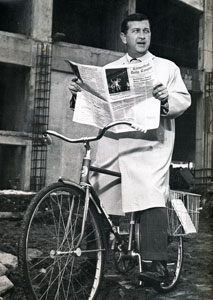  |
| HOME | THIS ISSUE | CALENDAR | GRANTS | BACK ISSUES | < BACK | NEXT > |
A piece of UConn historyBabbidge era recalled by former UConn publications directorby Karen A. Grava - September 11, 2006 |
||||
| In 1967 when Raymond J. Buck Jr. arrived in Storrs, President Homer Babbidge had one overriding concern: shedding UConn's 'cow college' image. "Babbidge was very sharp, very much a Yalie. He was determined to take the University away from its cow college image," says Buck. Just prior to Buck's arrival, the public information office had published a brochure about UConn with the title "Hardly a Wilderness," which was not well received because it emphasized everything the president wanted to avoid, he says. The campus was "delightfully agricultural," adds Buck, a former director of publications who is now retired. "All of the barns were used by animals, with the sheep barns especially visited regularly by children, and unsophisticated athletic programs. Buck remembers when the campus had a ski slope with a rope tow and lights for night use on Horsebarn Hill, a lot of wide open spaces, a student body with many active fraternities, and only a few cultural activities. "Babbidge and John G. Rohrbach, who was his financial person and had been his Yale classmate, turned the Beanery (cafeteria) into the art museum (now the William Benton Museum of Art) and really promoted the arts," Buck recalls. Babbidge used to jokingly refer to the architecture of the campus as "Mussolini Modern." It included an archery range for women where the psychology building is now, and open fields for softball and other women's sports on fields stretching from there all the way to Hillside Road. "It was one open field - no fences," Buck says. "Hawley Armory was the women's athletic facility, and where the Library, Information Technology, and Business Buildings are now were women's fields." One of Babbidge's plans for upgrading the campus sounds familiar - he wanted to build a beautiful village near Dog Lane and Route 195. The plan was never realized, however. Neither was his plan to build a new publications building near the Quaker Meeting House. Babbidge did introduce ducks (which have since been removed) to Mirror Lake, and began a program of placing blue bikes around campus. Students could come out of class and take one, leaving it at their next destination for someone else. But so many bikes were stolen that the program did not last for long. Life for Buck, who retired in the late 1980s, and his contemporaries in the administration was filled with black tie dinners, many at the president's residence, and other parties. The faculty was small and cohesive, and many faculty members belonged to a large gourmet group, with subgroups that made different recipes found in magazines.
Once, Buck recalls, the recipes were from a reception given by the U.S. President. The parties were popular and often lasted until 1 a.m. The social whirl did not die down until President Glenn Ferguson arrived in 1972. "Ferguson was very retiring," says Buck. "Sometimes he would step out of his own parties. His tenure changed things on campus." One of those changes was the new Storrs Beautification Committee, headed by Ferguson's wife, Patricia. It brought window boxes - still used today - to the Publications Building at the corner of Route 195 and Dog Lane. More fundamental changes occurred on campus with the war protests that took place in 1968, 1969, and 1970, Buck recalls. "The protests changed the character of the University. They threw the University off kilter," he says. Gulley Hall was occupied several times and Buck's own building, Publications, was firebombed by students who thought the then year-old administration paper, The Chronicle (forerunner to the Advance), was printed in the basement. The firebombing took out all the phone lines, but the paper was actually printed each week at the Willimantic Chronicle press. Thus, the words of the Portuguese ambassador were printed verbatim, even though students had hooted down his speech as a protest against the Vietnam War. "Babbidge escorted the man from the Jorgensen stage," says Buck, "but promised that the campus would have a chance to hear what he was going to say. We printed the whole speech." The protests also led the trustees to take a more active role in running the University, at times putting the president at loggerheads with the chairman of the board, Gordon Tasker. The two strongly disagreed, especially on the issue of instituting tuition in 1972. Babbidge was opposed on philosophical grounds, whereas Tasker, trained as an accountant, was concerned about paying the bills. Tasker prevailed. Babbidge eventually took a position at Yale University and ran - unsuccessfully - for governor in 1974.
This is one of a series of articles about UConn's history, celebrating the University's 125th anniversary. |
| ADVANCE HOME UCONN HOME |

